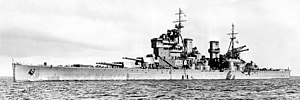Before any discussion of the Australian defence of New Guinea can begin we must look to the circumstances that made New Guinea an imperative defensive point for Australia. We must go back to the outbreak of World War 2 in the Pacific and the absolute might of an all-conquering Japanese military that saw not only the fall of Singapore but also the loss of Hong Kong, the American Fleet almost demolished at Pearl Harbour, the fall of the Philippines and General Douglas Macarthur’s abandonment of his forces in the Far East and his hasty retreat to Australia.
In the beginning - In September 1940 the Planning Chief of Imperial Army Headquarters in Tokyo, posing as a business executive on vacation, explored the island of Singapore and part of the Malayan peninsula. It takes the Japanese planners three days to satisfy themselves that Singapore can only be safely attacked from the mainland. A seaward affront would be disastrous.
One of Singapore's 15-inch coastal defence guns elevated for firing.
With the danger of war in the Pacific steadily growing, Air Chief Marshal Sir Robert Brooke-Popham arrives in November 1940 as Commander-in-Chief of the Far East.. Brooke-Popham opened his General Headquarters, Far East, in Singapore. In December two additional brigades (the 6th and 8th) arrive from India, and two British battalions (the 2/ East Surrey and 1/ Seaforth Highlanders) arrive from Shanghai. The military garrison then included 17 battalions - six British, ten Indian, and one Malay. In addition, the headquarters of the 11th Indian Division had reached Malaya. The Australian Prime Minister, Robert Gordon Menzies offered to send a brigade group to Malaya if necessary and this was accepted by Britain’s Prime Minister Winston Churchill.
In April 1941 the British military strategists in Singapore prepare a secret war plan codenamed "Matador". The new General Officer Commanding Malaya, Lieutenant-General Arthur Ernest Percival ho works out a strategy for his available forces. He plans for one division to defend southern Malaya, leaving a corps of two divisions to meet any attack on the north Malayan frontier. The plan calls for defending forces to cross the Malayan-Siamese frontier 24 hours ahead of any suspected Japanese landing in the southern reaches of the neighbouring kingdom, stopping the Japanese from gaining any beach-heads in southern Siam. Matador predicts that the Japanese were most likely to attempt landings at Singora and Patani and that the best place to stop them would be on the Patani road at a good defensive position called The Ledge.
On August 15 a large contingent of Australian troops arrive in Singapore. A high proportion of Australian forces in Asia were concentrated in Malaya during 1940 and 1941 as the threat from Japan increased. At the outbreak of war the Australian forces in Malaya comprised the 8th Division (less the 23rd Brigade) under the command of Major General Gordon Bennett, four RAAF squadrons and eight warships.
The Commanding Officer of Japan's 25th Army, Lieutenant-General Tomoyuki Yamashita, receives orders to proceed with the invasion of Singapore on November 30 and subsequently a state of emergency is declared in Singapore on 1st December.
Singapore is reinforced by the Royal Navy warships, HMS Prince of Wales and HMS Repulse. The HMS Prince of Wales had been completed in April 1941 and was nicknamed 'HMS Unsinkable' because of her special protective armour. The two capital ships sail in with four escort destroyers: HMS Electra, HMS Express, HMS Tenedos, and HMAS Vampire.
HMS Prince of Wales
HMS Repulse on manoeuvres in the 1920s
HMS Electra, "E" class destroyer built 1932
HMS Express, "E" class destroyer, launched 1934
HMS Tenedos, "S" class destroyer, Commissioned 1919
Hmas Vampire - "V" and "W" class destroyer built 1917
**************************************************************************





_IWM_FL_019818.jpg)

No comments:
Post a Comment